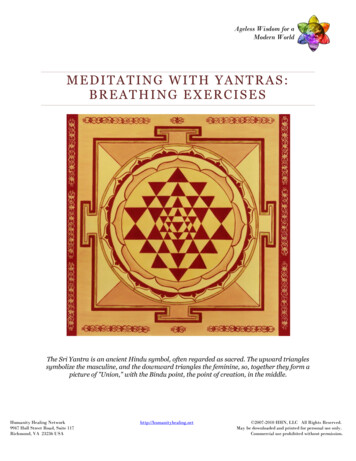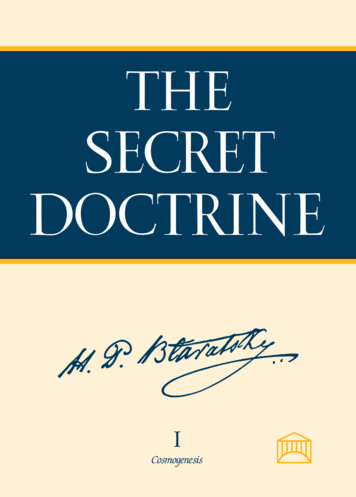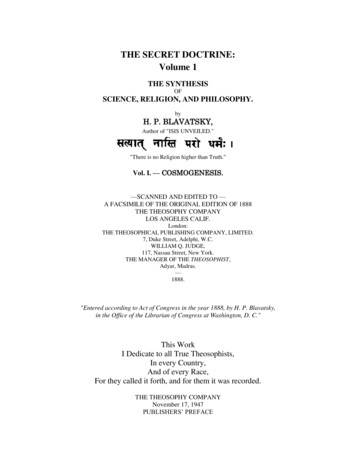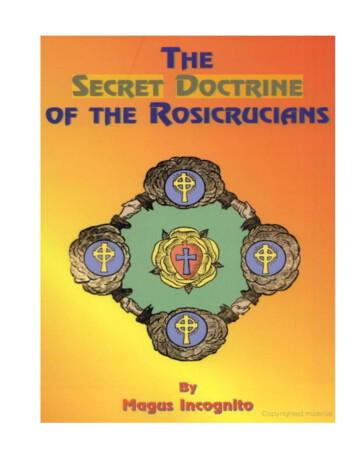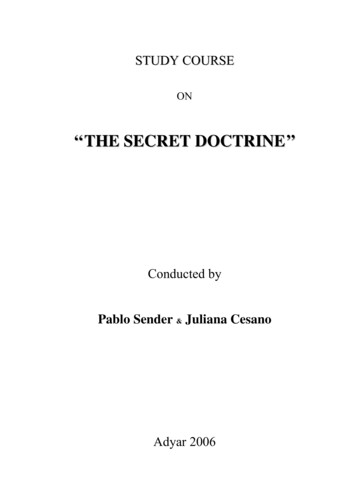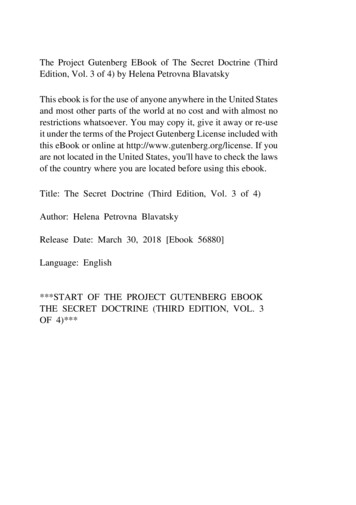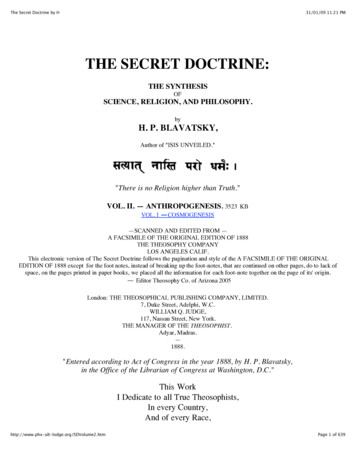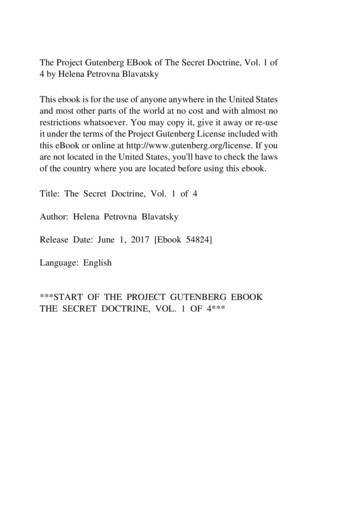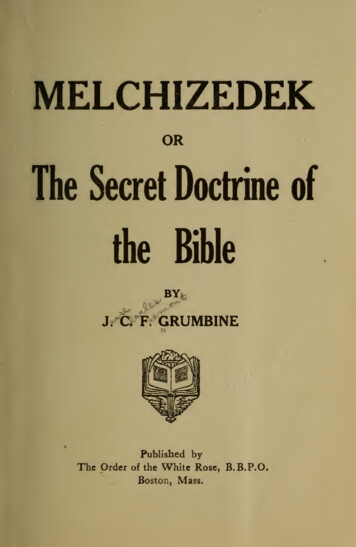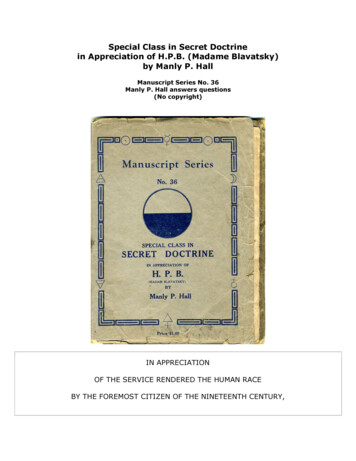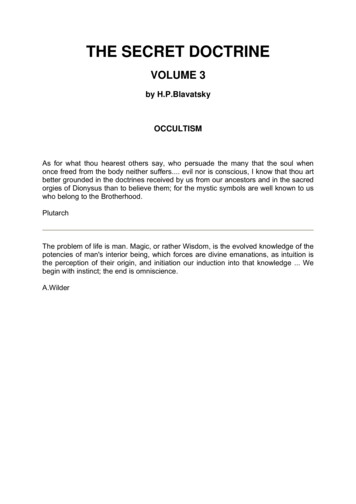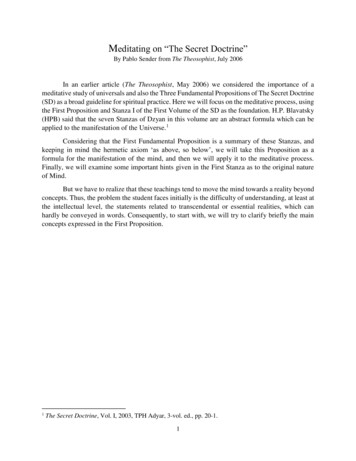
Transcription
Meditating on “The Secret Doctrine”By Pablo Sender from The Theosophist, July 2006In an earlier article (The Theosophist, May 2006) we considered the importance of ameditative study of universals and also the Three Fundamental Propositions of The Secret Doctrine(SD) as a broad guideline for spiritual practice. Here we will focus on the meditative process, usingthe First Proposition and Stanza I of the First Volume of the SD as the foundation. H.P. Blavatsky(HPB) said that the seven Stanzas of Dzyan in this volume are an abstract formula which can beapplied to the manifestation of the Universe.1Considering that the First Fundamental Proposition is a summary of these Stanzas, andkeeping in mind the hermetic axiom ‘as above, so below’, we will take this Proposition as aformula for the manifestation of the mind, and then we will apply it to the meditative process.Finally, we will examine some important hints given in the First Stanza as to the original natureof Mind.But we have to realize that these teachings tend to move the mind towards a reality beyondconcepts. Thus, the problem the student faces initially is the difficulty of understanding, at least atthe intellectual level, the statements related to transcendental or essential realities, which canhardly be conveyed in words. Consequently, to start with, we will try to clarify briefly the mainconcepts expressed in the First Proposition.1The Secret Doctrine, Vol. I, 2003, TPH Adyar, 3-vol. ed., pp. 20-1.1
Meditating on “The Secret Doctrine” by Pablo Sender from The Theosophist, July 2006The Process of ManifestationThis Proposition establishes that, whether the Cosmos is manifested or not, there is anAbsolute Reality called Parabrahman, the Rootless Root. This Reality is Omnipresent, Eternal,Immutable, and has no attributes. Indeed, Parabrahman is not a Being but the ‘Be-ness’, that whichmakes possible the existence of beings. But although the Absolute does not have qualities, we cansay It has two aspects, as described in the Proem:This “Be-ness” is symbolized in the Secret Doctrine under two aspects. On the one hand,absolute abstract Space, representing bare subjectivity, the one thing which no human mindcan either exclude from any conception, or conceive of by itself. On the other, absoluteAbstract Motion representing Unconditioned Consciousness.2Absolute abstract Space is called Mūlaprakṛiti, the Precosmic Root-Substance, which iscoeternal with Parabrahman. HPB says that its only representation in this plane is Space—a veryilluminating concept from a psycho-spiritual point of view, as we saw in the article mentionedabove. But also from a metaphysical viewpoint it brings an important understanding, because theAbsolute, like space, is neither affected nor modified by conditioned (manifested) things: ‘In theall-pervading space there exist clouds, stars, planets, dust-storms, and so on, but it [space] is nottouched by any of them’ says a Vedāntic scripture.3 However, this representation is necessarilylimited to describing absolute abstract Space, because it is not an empty space, as we may imagine:It is ‘neither a “limitless void”, nor a “conditioned fullness”, but both’.4 This abstract feminineprinciple, Mūlaprakṛiti, will give origin to the objective side of the manifested Cosmos, that is tosay, all the different states of matter (planes) and the vehicles of consciousness (bodies). Its symbolis a white circle.The Second aspect of Parabrahman is absolute abstract Movement. It is called the FirstLogos or Brahman (neuter) and is an abstract male aspect, because it is the Precosmic Ideation.The First Logos is the Germ of the Universal Mind, which will give origin to the subjective sideof manifestation, that is, to every kind of consciousness. Being an aspect of the Absolute, it is alsoeternal, but it is latent or active periodically. When active, it is called the First Cause of themanifested Universe, and is symbolized by a point within a circle.These three elements constitute the first metaphysical unmanifested Triad, which,nevertheless, is a Unity.But once the unmanifested Logos becomes active, the process of differentiation begins,and follows the Second Logos stage, called Ālaya, the Universal Over-Soul, which is semimanifested because it is a link between both states. At this point a subjective polarization in theUnity takes place. Although it is not an actual duality, it will give origin to all dualities in themanifested Cosmos (Spirit–Matter, Self–No Self, Subject–Object, Masculine–Feminine, Positive–Negative, and so on). Its symbol is a circle with a diameter.2Ibid., p. 14.Eleventh Book of the Śrimad Bhāgavata.4SD, I, p. 8.32V1.0 2018-07-06
Meditating on “The Secret Doctrine” by Pablo Sender from The Theosophist, July 2006And then comes the Third Logos, with which manifestation begins. It is called Brahmā,the Creator, or Mahat, the Universal Mind, the guiding intelligence in Evolution. At this stageduality takes place, and also a relationship between both poles arises, ‘something’ which linksspirit to matter, subject to object:This something . . . is called by the occultists Fohat. It is the ‘bridge’ by which the‘Ideas’ existing in the ‘Divine Thought’ are impressed on Cosmic substance as the ‘Lawsof Nature’. Fohat is thus the dynamic energy of Cosmic Ideation; or, regarded from theother side, it is the intelligent medium, the guiding power of all manifestation, the ‘ThoughtDivine’ transmitted and made manifest through the Dhyāni Chohans, the Architects of thevisible World.5The Third Logos then, is the first manifested Triad: Spirit-Fohat-Matter, KnowerKnowledge-Known, and so on, symbolized by a cross within a circle. At this point it may beuseful to summarize:Thus from Spirit, or Cosmic Ideation, comes our consciousness; from Cosmic Substancethe several vehicles in which that consciousness is individualized and attains to self — orreflective— consciousness; while Fohat, in its various manifestations, is the mysteriouslink between Mind and Matter, the animating principle electrifying every atom into life.6Hereafter, diversity takes place through a vast Hierarchy of Beings (Architects, Watchers,Builders, Planetary Spirits, and so forth) who build the Universe. Matter becomes grosser andgrosser while forming the Lower Cosmic Planes, and consciousness becomes more and moreconditioned. This stage of activity is represented by the svastika.Reversing the Process of ManifestationSo far, we have given a general overview of the manifestation processes. Now, we are in aposition to examine the stages described above from a psychological point of view. In our normalstate of consciousness, we are involved with a wide variety of psychological processes such asemotions, thoughts, memories, and longings. This state is represented by the svastika, the stage ofdiversity. But if we begin to examine ourselves, we will see behind all that movement there arejust three elements:(1.) The knower, which is the subject, the self, what we call ‘I’;(2.) the known, the object, the non-self, all that is external; and(3.) knowledge, the relationship between both, the reactions that arise in ‘me’ while incontact with the ‘other’.56SD, I, p. 16.SD, I, p. 16.3V1.0 2018-07-06
Meditating on “The Secret Doctrine” by Pablo Sender from The Theosophist, July 2006This triad represents the Third Logos. Through proper meditation, observing calmly andattentively this diversity of processes within us, we can reach a point of non-reaction, of justawareness of all that is happening. It requires that we allow all thoughts, sensations, and so on, toarise and disappear by themselves, without interfering, just watching. And then we have raisedourselves above the plane of relationship between self and non-self. However, although there is noreaction, we are observing from a centre, that is, there still is a sense of ‘I am aware of thepsychological movement’, ‘the movement and me are different’. So, this is a state of duality, theSecond Logos stage.If we remain silent, quiet, in that condition, it is possible to leave behind the sense ofduality. Then ‘the observer is the observed’, as J. Krishnamurti (JK) frequently said. This is a stateof unity, symbolized in the First Logos. And now the door is open to reach a qualitatively differentkind of consciousness, represented by Parabrahman, the Absolute beyond the reach of thought. Aswe can see, the process described is the principle of Rāja Yoga; we have to reverse within us thecourse of manifestation. This is represented by many mystical teachings, for example, when in TheVoice of the Silence we read ‘The rose must re-become the bud born of its parent stem’ (v. 77) or‘the drop returneth whence it came’ (v. 181).Meditating on the First Stanza of CosmogenesisThe First Stanza of Cosmogenesis describes the Absolute, the original state from which allcreative forces appear. As the human being is the mirror of the Cosmos, Parabrahman can be seenas a Macrocosmic description of that state which corresponds to our mental consciousness whenit is at its highest point, in its original nature. We must remember what HPB said, that when wereach the highest degree possible on a plane (the seventh subplane, the homogeneous one), theconsciousness can pass to the immediately superior:The seventh [degree] bridges across from one plane to another. The last is the idea, theprivation of matter, and carries you to the next plane. The highest of one plane touches thelowest of the next. 7This is an important subject, because it is the very foundation of certain practicaltheosophical teachings, but it is beyond the scope of this article. Nevertheless, if we bear in mindthis fact while working on what follows, this Stanza can be seen as a description of that state ofuniversality where the self is silent and the Other may make contact. Of course, it is not throughthe ordinary action of our brain-consciousness (kāma-manas) that we can realize that state, but ifwe reflect deeply about what the Stanza says and work on it, then ‘the fire of knowledge burns upall action on the plane of illusion’8 and we can have an intimation from the plane of reality.78SD, V, 1962, TPH Adyar, 6-vol. ed.SD, I, 2003, p. 87.4V1.0 2018-07-06
Meditating on “The Secret Doctrine” by Pablo Sender from The Theosophist, July 2006I will not present the śloka-s of this Stanza in a literal form, but the concept will be conveyed in away useful for our present purpose. Besides, we should try to apply the statements as referring toMan, instead of to the Macrocosms. Thus, in the Original state of Mind:I.1. The only presence was the (infinite) Space: This is the basic Reality, as we have already seen.Therefore, our direction is towards non-identification with the inner movement but with that whichencloses all psychological activity. Our consciousness is habituated to perceiving everything fromthis restricted point which is the personality, but here we have to expand our mind to the infiniteand rest in a sense of non-limitation to this particular point in space.I.2. Time was not; it lay in the infinite duration: In her comments, HPB says that ‘time is only anillusion produced by the succession of our states of consciousness’ or as JK would say: ‘Timebelongs to the brain’ and ‘time is based on thought’. Therefore, when we dwell on being all Space,we embrace every movement. There is no perception of something as ‘internal’ or ‘external’. Allis within: the brain-born activity as well as Nature’s sounds. Slowly we merge into the state of aquiet, full presence, without the sense of time.I.3. Mind was not; there was no one to contain it and hence to manifest it: From a microcosmicpoint of view, ‘mind’ here means our lower mind, kāma-manas. Thought cannot conceive (and,therefore, functions) in a state of Infinity (śloka I.1) and Eternity (śloka I.2). As JK has said: ‘Thethinker is the thought. There is no thinker separate from thought.’9 In this state the brainconsciousness and its product, the self, ceases.I.4. The way to bliss and the cause of misery were not, for there was no one to produce and getensnared by them: The self is limited, and is the source of separateness from which attractions andrepulsions arise. Therefore, when this illusory center is not, there is neither struggle to be happynor possibility of sorrow. But then, what is there?I.5. Darkness alone filled the boundless all.I.6. All is immersed in Absolute Non-Being. Naught was: When there is no ‘self’, from thestandpoint of the lower consciousness, all is in darkness. But is this state where ‘naught was’merely an annihilation, an unconscious state like when we are knocked out? The followingdialogue between JK and Dr David Bohm gives us a hint:JK: Consciousness is made up of all that it has remembered: beliefs, dogmas, rituals, fears,pleasures, sorrow.DB: Yes. Now if all that were absent, would there be no consciousness?JK: Not as we know it.DB: But there would still be a kind of consciousness?JK: A totally different kind.109The Future of Humanity, First Conversation, Brockwood Park, 11 June 1983.Idem.105V1.0 2018-07-06
Meditating on “The Secret Doctrine” by Pablo Sender from The Theosophist, July 2006I.7. The causes of existence had been done away with, all rested in eternal nonbeing — the onebeing.I.8. Alone the one form of existence stretched boundless, infinite, causeless throughout that AllPresence which is sensed by the opened eye of the purified soul: In the previous quote JK said thatwhen the self is absent there remains ‘a totally different kind of consciousness’. Maybe he isreferring to that ‘non-being’, the One being. But we should note that, as the Stanza asserts, thisstate is ‘causeless’, and appears when ‘the causes of (personal) existence are done away’ with.How is this done? In Vedānta philosophy it is said that Ātman (the One Being) is like the suncovered by the clouds (the personal self). When the wind (spiritual perception) removes the clouds,the sun shines. But the sun was not produced by the wind; it acted over the clouds, while the sunitself remains always the same, untouched. Therefore, in order to awaken spiritual consciousness(sunlight) nothing is to be added, only removed. Spiritual Consciousness is not produced by anyconditioned movement, but arises when the self is absent. As JK said:To put it very simply, when the self is not, there is beauty, silence, space; then thatintelligence, which is born of compassion, operates through the brain. It is very simple.11So, this state comes freely, spontaneously. However, it does not mean that it will appear magically,without requiring any work from us. All spiritual discipline aims to ‘prepare the ground’ wherethat state may come into existence, and without the necessary work it is almost impossible for thisselfless awareness to appear. JK gave as an example that if you open the window, the breeze mayenter. You cannot produce the breeze, you can only keep the window open; but if you do not openthe window, then the breeze will never enter.And what will keep the window open? The śloka refers to ‘that all-presence which is sensed bythe opened eye of the purified soul’. The ‘purified soul’ could represent that alertness, with anon-centred presence where the Intuition or spiritual perception can manifest:DB: Now if the brain is silent, if it is not thinking of a problem, then still the space islimited, but it is open to . . . .JK: . . . to the other.DB: Would you say that, through attention, or in attention, the mind is contacting thebrain? . . . Does it (intelligence) operate through attention?JK: Of course.DB: So attention seems to be the contact.JK: Naturally. We said too that attention can only be, when the self is not.121112The Future of Humanity, Second Conversation, Brockwood Park, 20 June 1983.Idem.6V1.0 2018-07-06
Meditating on “The Secret Doctrine” by Pablo Sender from The Theosophist, July 2006I.9. Then, all were in the absolute reality: Finally, mental consciousness reaches the absolute realityof its own level. And from that state, creative powers can arise, modifying the very structure of thebrain to give form to a more suitable vehicle for this new and different kind of energy andconsciousness. As JK has it:So can the brain, with all its cells conditioned, can those cells radically change? . . . We aresaying that they can, through insight; insight being out of time, . . . It has nothing to dowith any time and thought. 13This could be one of the reasons why HPB said, about working with the SD:Ordinary intellectual activity moves on well-beaten paths in the brain, and does not compelsudden adjustments and destructions in its substance. But this new kind of mental effortcalls for something very different—the carving out of ‘new brain paths’, the ranking indifferent order of the little brain lives.14The Theosophist, July 2006www.pablosender.com1314The Future of Humanity, First Conversation.Robert Bowen, Madame Blavatsky on How to Study Theosophy, TPH Adyar, pp. 12-13.7V1.0 2018-07-06
Meditating on “The Secret Doctrine” by Pablo Sender from The Theosophist, July 2006 2 V1.0 2018-07-06 The Process of Manifestation This Proposition establishes that, whether the Cosmos is manifested or not, there is an Absolute Reality called Parabrahman, the Rootless Root. This Reality i
